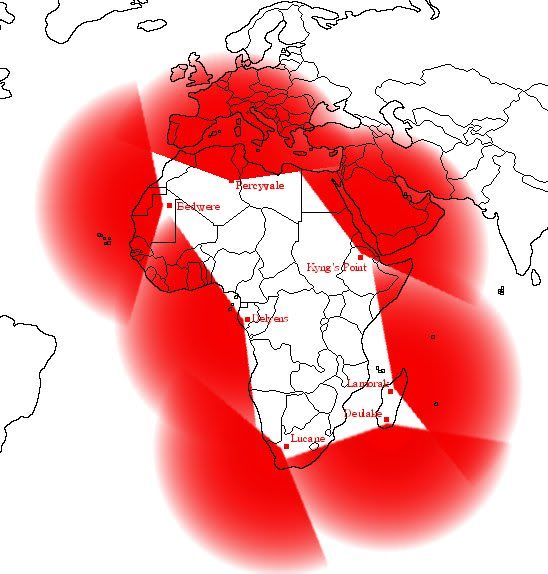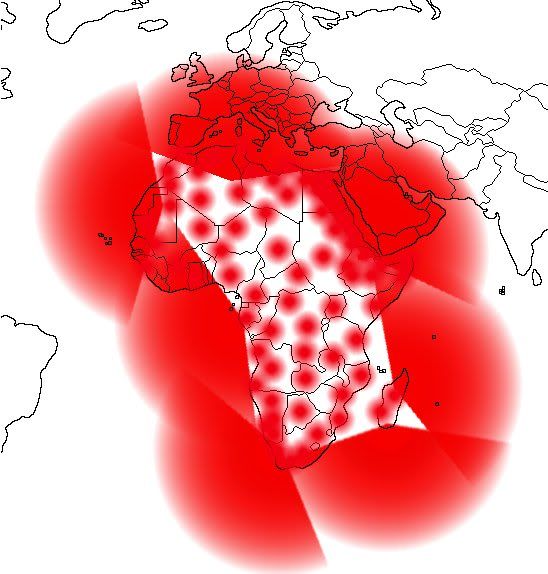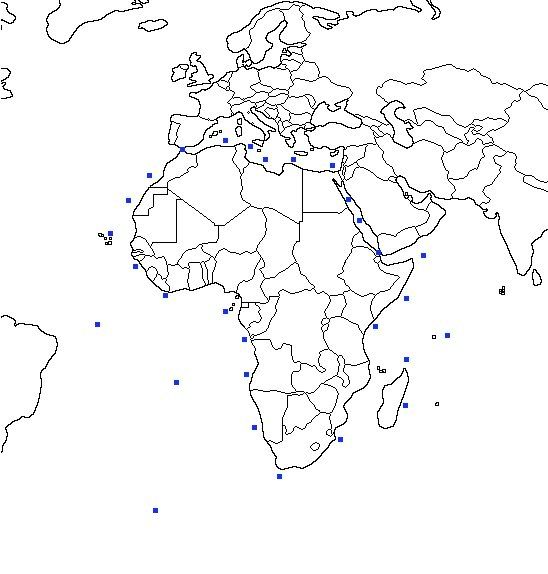Name - The silver wrath. MDD - Massive Distortion Device
Class - Superweapon
Function - Upon release, a supercharged purifier engine releases all of it's power creating an extremely powerful distortion field with a very respectable blast radius. This in turn releases a supercharged ION effect which disables even the most protected systems in the region. The third charge is a mix of a shock wave and a gas substance known as purified phosphorus, which in turn creates a violent hurricane-like effect with the environment lasting about 10 seconds or so. The majority of matter caught in the blast radius is likely to disintegrate or wholesomely get eradicated. It is originally developed for anti-chaos properties, but can just as easily be used against civilized nations as well. Punja modeled this after God's final wrath on Egypt, and the beautiful, silvery snow twilight the weapon leaves behind certainly can hint towards our imagination of such an effect. It takes a great amount of time and caution to supercharge a large purifier engine so this weapon is not easy to produce. At current, Punja is the only one capable of creating one.
Factbook of Nations
33 posts •
Page 2 of 2 •
- 1
- 2
DEW Network Pt. 1
[font="Book Antiqua"][SIZE="5"]- ZODEAC MILCOM -
THE DEW NETWORK[/SIZE]
[SIZE="3"]By: Aaron Shadowtail[/SIZE][/font]l
THE DEW NETWORK[/SIZE]
[SIZE="3"]By: Aaron Shadowtail[/SIZE][/font]l
The modern political climate has given rise to ever increasing military needs. While a tenuous peace has remained over the globe, the NHRE has, at the writing of this report, continued to instigate ever more acts of aggression towards our country. It was thus, with great wisdom, that the Triumvirate enacted Prop 3017. This act went a long distance in updating our military structure at that time, all the way through the present and will be a potent tool for any future military conflict. One such result of Prop 3017 was the development of a powerful Detection Early Warning (DEW) Network designed to fully observe, identify and communicate any potential threat to our national security.
The Detection Early Warning (DEW) Network is a collection of systems which observe, identify and communicate the presence of airborne military threats to responsible military parties within ZODEAC. It utilizes RADAR, IRST, and Optical technologies to help provide a continuous, sense of the military situation both within and outside of ZODEAC's borders.
[font="Book Antiqua"][SIZE="3"]RADAR Systems [/SIZE][/font]
The primary ballistic missile and air-defense warning system is powered by a set of RADAR facilities scattered across ZODEAC. The DEW OTH (Over The Horizon) system consists of 7 Over The Horizon (OTH) RADAR complexes, designed to provide continuous coverage of any large scale military air-force movements in the NHRE, the Atlantic and the Indian Ocean.

Fig. 1.0: Bedwere OTH RADAR complex that can extend out as far as 3500 km, it provides a powerful method of detecting military bomber aircraft from Europe, all the way down to the equator.
The names of these 7 military complexes are,
--- Kyng's Point
--- Percyvale
--- Bedwere
--- Lucane
--- Deulake
--- Delyens
--- Lamorak

Fig. 1.1: A RADAR Map of the 7 OTH RADAR Complexes and their approximate range (these systems can vary heavily from day-to-day, which requires other RADAR complexes to monitor their alert status depending upon the effective search range of the complex at the time)
While the tracking capabilities of OTH RADAR complexes is hardly accurate enough to coordinate missile launches, it can provide the intel necessary to put a region on alert, increasing the power to local RADAR systems, providing local AEWACs air-craft with general mission coordinates and putting RFX-4 aircraft in the air with proper payload outputs. Precision RADAR support however, can only be achieved through a combination of Short-Long Range RADAR Systems, AEWACs regional support units and IRST stations.

Fig 1.2: An image of an AN/FPS-117 Phased RADAR Installation.
The most powerful of these units is the AN/FPS-117 Phased RADAR Installation. These RADAR sites provide the greatest power in tracking any air-craft in the sky.

Fig 1.3: ZODEAC's AN/FPS-117 stationary RADAR coverage.

Fig 1.4: Combined Coverage of the AN/FPS-117 and OTH systems.
These points utilize AN/FPS-117 RADAR systems, with 70 total stationary facilities scattered throughout the nation. The installations are commonly placed along "Achilles" points, where RADAR coverage from OTH RADAR complexes end and are hence weakest. These are generally combined in threes to provide extremely powerful RADAR coverage in the event that an attack somehow manages to follow one of these vectors. Furthermore, because of our proximity with the NHRE, a powerful web of these RADAR installation is present along said border, to maintain RADAR surveillance even in the event that the NHRE does develop and deploy a stealthier class of air-borne units. Finally web of 5 such units surrounds the capital region, providing some of the densest RADAR coverage there in the entire country.
However, if you believed the above figure represents the whole of ZODEAC air-surveillance RADAR, you would be quite wrong. This is simply the primary collection of major permanent RADAR installations. These systems are in turn complimented by 21 AN/TPS-77 mobile RADAR installations, which is essentially a mobile version of the AN/FPS-117. These systems are moved to regions where air-borne threats are perceived to be the highest and are camouflaged from view, they keep powered down until a threat is detected or observed, at which point they turn on, providing a host of dead ends in any gaps the enemy may try to move through within the ZODEAC DEW network. As a tight turn by any stealthy air-craft negates it's geometric stealth capabilities, such a dead end would force the pilot to reveal his position and expose his air-craft to more refined tracking and anti-aircraft munitions.

Fig 1.5: The mobile AN/TPS-77 ready for regional RADAR support.
Additionally, the nation is covered in a far larger grid of medium and short range RADAR installations (such as the AN/FPS-114), both as stationary infrastructure and as mobile units. As with the AN/TPS-77, these units are typically scattered more heavily along regions where the AN/FPS-117 power rating is weakest, they also often cease to operate except in the event of a suspected air-born attack. These systems are also complimented by squadrons of AEWACS aircraft and SENS03 War Tzar Combat Vehicles.

Fig 1.6: A ZODEAC AEWACS, which is a derivative of the Cargo Air-transport aircraft.
A further layer of security is provided by Gorshkov MK II. Cruisers, whose onboard AN/SPY-3 RADAR suite can track targets out to 375 km. At the current writing of this document, a total of [url="]72 of these units (18 Squadrons)[/url] provide continuous coverage over the Red Sea, the Mediterranean Sea, The Atlantic and the Indian Ocean - with even more such units planned for the future. In addition to providing it's own dynamic highly powerful RADAR grid beyond the borders of ZODEAC, these platforms are also armed with additional RADAR and IRST capabilities, [url="http://en.wikipedia.org/wiki/AMDR]AMDR[/url] for anti-ballistic missile and anti-stealth capabilties, Infra-Red Search & Track (IRST) capabilities for enhanced anti-stealth capabilities and and RIM-174 missiles ready to take down any ballistic missile or air-craft threats to our borders.
The time may indeed come in the not to distant future, where a combination of these AEGIS systems and AEWACs based systems completely eliminate the need for Over The Horizon (OTH) RADAR complexes. But in the meantime, a combination of these potent systems and a collection of other RADAR facilities and units provide a first-rate early warning system.
-

Dante - Posts: 1323
- Joined: Thu Mar 04, 2004 8:24 pm
- Location: Where-ever it is, it sure is hot!
DEW Network Pt. 2
[font="Book Antiqua"][SIZE="3"]Anti-HARM Systems[/SIZE][/font]
To protect RADAR infrastructure, ZODEAC has taken to applying several protective measures beyond the presence of military units. While these units are, of course, critical to protecting our RADAR installations, they can do little against HARM missiles.
That is why the 7 OTH RADAR complexes and many others are defended by Millennium Guns, which are essentially the same units found on Gorshkov MK II. Cruisers. Several such units can be found mounted around OTH RADAR installations and occasionally a similar system can be found near high priority AN/FPS-117 facilities.
Beyond this active defense mechanism however, these sites also utilize passive defense mechanisms as well. OTH and important AN/FPS-117 facilities are surrounded by a large number of redundant transmitters. These transmitters are synchronized with the primary RADAR pulses in both time and power so that any RADAR seeking HARM weapon cannot distinguish between RADAR signatures from the primary RADAR and the decoys.
However, because these decoys have significantly less power, their RADAR beam must be far narrower in space then it's larger twin. Thus, these units also act as short range search and track systems, tracking the HARM missile and actively using computer controls from the facility to direct the missile away from the facility to a location that places neither the decoys or the primary facility at risk.
Systems such as these are meant to highly reduce the threat that HARM missiles pose to our RADAR facilities. This will force enemy units to use other detection methods, such as IR or optical measures, for which IR-Optical camouflage nets provide ample detection reduction capabilities.
[font="Book Antiqua"][SIZE="3"]
ZODEAC SONAR Grid[/SIZE][/font]

Fig 1.7: The ZODEAC Sonar Grid
While it is not a direct component of the DEW network, it is equally important to note that ZODEAC also employs an array of underwater passive sonar sensors that provide ZODEAC with a clear picture of any underwater naval threats. These systems, provide critical intelligence gathering capabilities at key points, like the Suez Canal and the Straits of Gibraltar. However, they also provide a continuous monitoring along the costal region, as well as at strategic island locations where these systems can be mounted.
Information from these underwater hydrophones is collected and then sent into ZODEAC where triangulation is used to track any potential underwater noise and advanced classification algorithms can be run to determine the source of the sound. In this manner, the underwater SONAR grid is a kind of early warning program for submarine activity. Combined with Gorshikov MK II. Cruiser and the upcoming Vidar Class Attack Submarine these systems will provide a dynamic tool in monitoring the open ocean for military and pirating activity - providing security for our nation and it's assets. ading back into the shadows.
To protect RADAR infrastructure, ZODEAC has taken to applying several protective measures beyond the presence of military units. While these units are, of course, critical to protecting our RADAR installations, they can do little against HARM missiles.
That is why the 7 OTH RADAR complexes and many others are defended by Millennium Guns, which are essentially the same units found on Gorshkov MK II. Cruisers. Several such units can be found mounted around OTH RADAR installations and occasionally a similar system can be found near high priority AN/FPS-117 facilities.
Beyond this active defense mechanism however, these sites also utilize passive defense mechanisms as well. OTH and important AN/FPS-117 facilities are surrounded by a large number of redundant transmitters. These transmitters are synchronized with the primary RADAR pulses in both time and power so that any RADAR seeking HARM weapon cannot distinguish between RADAR signatures from the primary RADAR and the decoys.
However, because these decoys have significantly less power, their RADAR beam must be far narrower in space then it's larger twin. Thus, these units also act as short range search and track systems, tracking the HARM missile and actively using computer controls from the facility to direct the missile away from the facility to a location that places neither the decoys or the primary facility at risk.
Systems such as these are meant to highly reduce the threat that HARM missiles pose to our RADAR facilities. This will force enemy units to use other detection methods, such as IR or optical measures, for which IR-Optical camouflage nets provide ample detection reduction capabilities.
[font="Book Antiqua"][SIZE="3"]
ZODEAC SONAR Grid[/SIZE][/font]

Fig 1.7: The ZODEAC Sonar Grid
While it is not a direct component of the DEW network, it is equally important to note that ZODEAC also employs an array of underwater passive sonar sensors that provide ZODEAC with a clear picture of any underwater naval threats. These systems, provide critical intelligence gathering capabilities at key points, like the Suez Canal and the Straits of Gibraltar. However, they also provide a continuous monitoring along the costal region, as well as at strategic island locations where these systems can be mounted.
Information from these underwater hydrophones is collected and then sent into ZODEAC where triangulation is used to track any potential underwater noise and advanced classification algorithms can be run to determine the source of the sound. In this manner, the underwater SONAR grid is a kind of early warning program for submarine activity. Combined with Gorshikov MK II. Cruiser and the upcoming Vidar Class Attack Submarine these systems will provide a dynamic tool in monitoring the open ocean for military and pirating activity - providing security for our nation and it's assets. ading back into the shadows.
-

Dante - Posts: 1323
- Joined: Thu Mar 04, 2004 8:24 pm
- Location: Where-ever it is, it sure is hot!
33 posts •
Page 2 of 2 •
- 1
- 2
Return to RPGs and Roleplaying
Who is online
Users browsing this forum: No registered users and 120 guests
